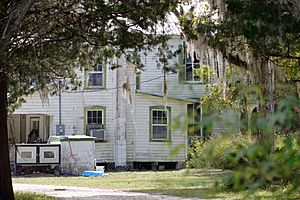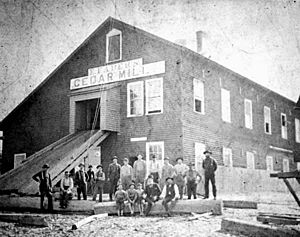Rosewood, Florida facts for kids
Quick facts for kids
Rosewood, Florida
|
|
|---|---|

House remaining in Rosewood
|
|
| Country | |
| State | |
| County | Levy |
| Time zone | UTC-5 (Eastern (EST)) |
| • Summer (DST) | UTC-4 (EDT) |
| ZIP code |
32625
|
| Area code(s) | 352 |
Rosewood is an unincorporated community in Levy County, Florida, located just off State Road 24 approximately 1 mile (1.6 km) northeast of Sumner and 9 miles (14 km) northeast of Cedar Key. An African-American community prospered there in the early 20th century, until a white mob destroyed it in the 1923 Rosewood massacre.
History

Rosewood was settled in 1845, nine miles (14 km) east of Cedar Key, near the Gulf of Mexico. Local industry centered on timber. The name Rosewood refers to the reddish color of cut cedar wood. Two pencil mills were nearby in Cedar Key; several turpentine mills and a sawmill three miles (4.8 km) away in Sumner helped support local residents, as did farming of citrus and cotton. The hamlet grew enough to warrant the construction of a post office and train depot on the Florida Railroad in 1870, but it was never incorporated as a town.
The initial settlers of Rosewood were both black and white. When most of the cedar trees in the area had been cut by 1890, the pencil mills closed, and many white residents moved to Sumner. By 1900, the population in Rosewood had become predominantly black. The village of Sumner was predominantly white, and relations between the two communities were relatively amicable. The population of Rosewood peaked in 1915 at 355 people. Two black families in Rosewood named Goins and Carrier were the most influential. The Goins family brought the turpentine industry to the area, and in the years preceding the attacks, were the second largest landowners in Levy County. To avoid lawsuits from white competitors, the Goins brothers moved to Gainesville, and the population of Rosewood decreased slightly. The Carriers were also a large family, responsible for logging in the region. By the 1920s, almost everyone in the close-knit community was distantly related to each other. Although residents of Rosewood probably did not vote because voter registration requirements in Florida had effectively disfranchised blacks since the turn of the century, both Sumner and Rosewood were part of a single voting precinct counted by the U.S. Census. In 1920, the combined population of both towns was 344 blacks and 294 whites.
As was common in the late 19th century South, Florida had imposed legal racial segregation under Jim Crow laws, requiring separate black and white public facilities and transportation. Blacks and whites created their own community centers: in 1920, the residents of Rosewood were mostly self-sufficient. They had three churches, a school, a large Masonic Hall, a turpentine mill, a sugarcane mill, a baseball team named the Rosewood Stars, and two general stores, one of which was white-owned. The village had about a dozen two-story wooden plank homes, other small two-room houses, and several small unoccupied plank farm and storage structures. Some families owned pianos, organs, and other symbols of middle-class prosperity. Survivors of Rosewood remember it as a happy place. In 1995 survivor Robie Mortin recalled at age 79, "Rosewood was a town where everyone's house was painted. There were roses everywhere you walked. Lovely."
Economy
Before 1923

Rosewood was settled in 1845, 9 miles (14 km) east of Cedar Key, near the Gulf of Mexico. The local industry was centered on timber. Two pencil mills were nearby in Cedar Key; several turpentine mills and a sawmill 3 miles (5 km) away in Sumner helped support local residents, as did farming of citrus and cotton. The hamlet grew enough to warrant the construction of a post office and train depot on the Florida Railroad in 1870, but it was never incorporated as a town.
Decline of Rosewood's economy (1923–1950)
In 1923, during the infamous Rosewood massacre, the entire town of Rosewood was razed except for John Wright's General Store. After the majority of the population fled Rosewood, the once profitable turpentine industry began to fade as newer, alternative synthetic products were being produced. By 1950, the turpentine industry practically no longer existed.
Since 1950
Since the 1950s, several businesses were established in Rosewood, including a general store; fisheries; charter tours; clam, oysters and other types of Mollusca farmers; agricultural farms; restaurants; storage facilities and a small airfield. Several neighborhoods have been developed around these businesses.

